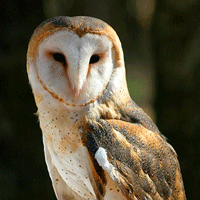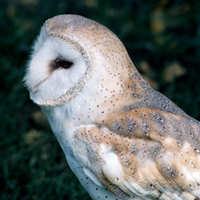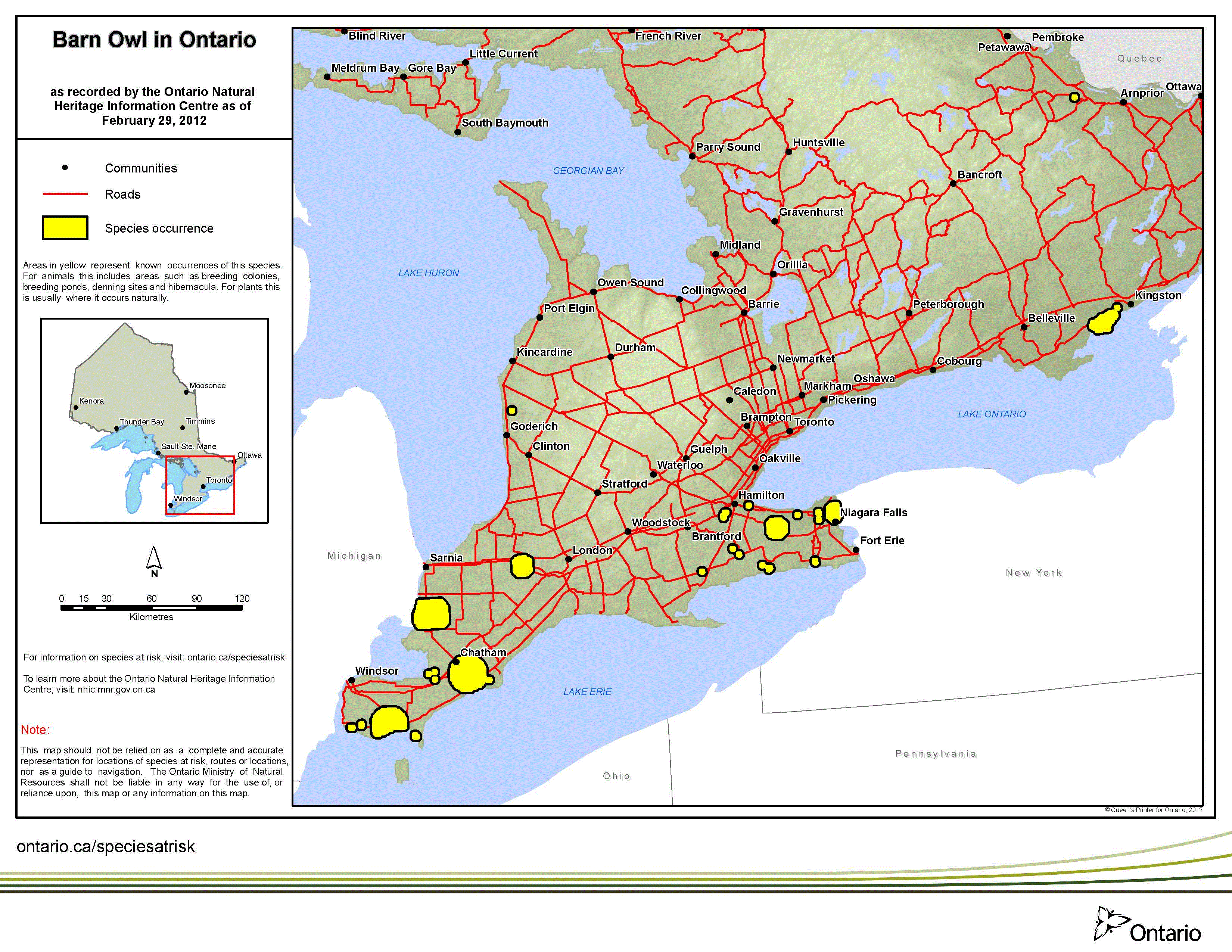Barn owl
Scientific name: Tyto alba


Cover photos credit: J.D. Taylor
Status
Endangered
Endangered
means the species lives in the wild in Ontario but is facing imminent extinction or extirpation.
Date added to the Species at Risk in Ontario List
The Barn Owl was already assessed as endangered when the Endangered Species Act took effect in 2008.
What it looks like
This distinct looking owl is easily identified by its white heart-shaped face, black eyes, golden colour, pale, lightly speckled under parts, and long legs.
Another key feature of the barn owl is that it lacks the “ear tufts” found on other types of owls in Ontario.
The Barn Owl is a mid-sized owl, growing 35 cm - 45 cm tall.
While many other owls hoot or whistle, the Barn Owl’s call consists of hisses, screams, cries and other strange noises.
Where it lives
The Barn Owl is found on all continents except Antarctica. In Canada, the species breeds only in extreme southern Ontario and British Columbia.
The Barn Owl is extirpated (no longer found) in Michigan and has declined in other parts of the northeastern and midwestern parts of the United States.
Where it’s been found in Ontario
The Barn Owl cannot tolerate severe winter temperatures, and southern Ontario is the northern limit of its range. Breeding sites in Ontario seem to be restricted to areas with the moderating effects of the Great Lakes (within 50 kilometres of the lakes).
In southern Ontario, this adaptable owl nests and roosts in barns and abandoned buildings.
It may also use natural cavities in trees or holes in cliff faces, as it did before the arrival of Europeans in North America.
It lives year round at its nest site and hunts for rodents over orchards, and grasslands such as farmlands, fallow fields and meadows.
Today, there are fewer than five pairs of Barn Owls in Ontario.
View a Larger version of this map (PDF)
What threatens it
The Barn Owl needs grassland habitats, and these are being lost to urbanization and changing farm practices.
As traditional wooden farm buildings are torn down and replaced by more modern bird proof
barns, this owl loses suitable nesting sites.
Loss of habitat for the Barn Owl’s prey (rodents such as voles) also poses a threat to the owl’s survival.
Road mortality is also an issue for these owls, who fly low along roadways at night on the hunt for prey in adjacent grassy areas.
Action we are taking
Endangered Species and their general habitat are automatically protected
Recovery strategy
A recovery strategy advises the ministry on ways to ensure healthy numbers of the species return to Ontario.
Read the executive summary (February 18, 2010)
Read the recovery strategy (February 18, 2010)
Government response statement
A government response statement outlines the actions the government intends to take or support to help recover the species.
Read the government response statement (November 18, 2010)
Five-Year Review of Progress
A five-year review reports on progress made toward protecting and recovering a species, within five years of publishing a species’ government response statement.
Read the report on progress towards the protection and recovery of 13 species at risk, including Barn Owl (2015)
Habitat protection
A habitat regulation defines a species' habitat and many describe features (for example, a creek, cliff, or beach), geographic boundaries or other unique characteristics.
Read the regulation
What you can do
Report a sighting
- Report a sighting of an endangered animal or plant to the Natural Heritage Information Centre. Photographs with specific locations or mapping coordinates are always helpful.
Volunteer
- Volunteer with your local nature club or provincial park to participate in surveys or stewardship work focused on species at risk.
Be a good steward
- Private land owners have a very important role to play in species recovery. If you find a Barn owl nesting on your land, you may be eligible for stewardship programs that support the protection and recovery of species at risk and their habitats.
- Barn Owls have been found in artificial structures, such as buildings, silos and nest boxes. A provincial recovery team has erected nestboxes for the Barn Owl. You can volunteer by installing or monitoring these nest boxes in and near grassland areas. For information on nest boxes and the work of the Ontario Barn Owl Recovery Project, visit the Bird Studies Canada website.
- Human disturbance during nesting season may force Barn Owls to abandon their nests and their young. If you have Barn Owls on your property, try to minimize any activity or disturbance during the nesting season.
- Bird Studies Canada is working to advance the understanding, appreciation and conservation of wild birds and their habitat in Ontario and elsewhere. For more information on how you can help, visit: Birds Canada.
Report illegal activity
- Report any illegal activity related to plants and wildlife to
1-877-TIP-SMNR (847-7667) .
Quick facts
- Barn Owls live only two to four years in the wild and have many predators including raccoons, cats and great horned owls.
- Pairs of Barn Owls use the same nest year after year. This trait is known as
site fidelity.
